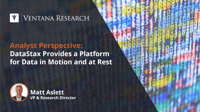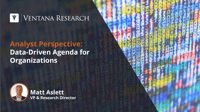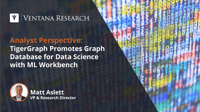Streaming data has been part of the industry landscape for decades but has largely been focused on niche applications in segments with the highest real-time data processing and analytics performance requirements, such as financial services and telecommunications. As demand for real-time interactive applications becomes more pervasive, streaming data is becoming a more mainstream pursuit, aided by the proliferation of open-source streaming data and event technologies, which have lowered the cost...
Read More
Topics:
Data,
Streaming Analytics,
Streaming Data & Events,
operational data plaftforms
When joining Ventana Research, I noted that the need to be more data-driven has become a mantra among large and small organizations alike. Data-driven organizations stand to gain competitive advantage, responding faster to worker and customer demands for more innovative, data-rich applications and personalized experiences. Being data-driven is clearly something to aspire to. However, it is also a somewhat vague concept without clear definition. We know data-driven organizations when we see them...
Read More
Topics:
embedded analytics,
Analytics,
Business Intelligence,
Data Governance,
Data Integration,
Data,
Digital Technology,
natural language processing,
data lakes,
data operations,
Streaming Analytics,
AI & Machine Learning,
Digital Business,
Data Platforms,
Analytics & Data,
Streaming Data & Events
I recently wrote about the growing range of use cases for which NoSQL databases can be considered, given increased breadth and depth of functionality available from providers of the various non-relational data platforms. As I noted, one category of NoSQL databases — graph databases — are inherently suitable for use cases that rely on relationships, such as social media, fraud detection and recommendation engines, since the graph data model represents the entities and values and also the...
Read More
Topics:
business intelligence,
Analytics,
Cloud Computing,
Data,
Digital Technology,
AI & Machine Learning,
Data Platforms,
Analytics & Data












